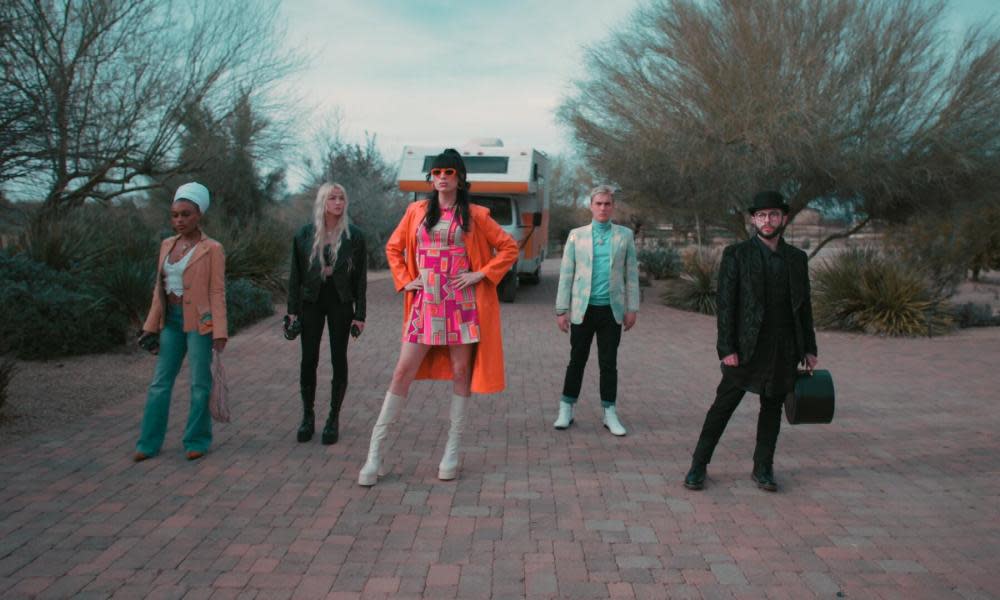Twilight Slayance: Kristen Stewart’s queer ghost-hunting show is a scream

In her post-Twilight decade of work with arthouse auteurs, Kristen Stewart has developed her own style of playing the misfit. Lip: chewed. Collar: tugged. Hair: tousled. When the real world comes up short, some of her most memorable characters have looked to the great beyond for answers. In Spencer, her young Diana finds a spiritual sibling in a beheaded queen from Tudor times; Personal Shopper saw her fall prey to a paranormal hoax before a haunting encounter with the shadow world.
Related: Kristen Stewart’s 20 best performances – ranked!
Stewart’s taste for the paranormal runs deep. Her new executive-produced show Living for the Dead is a ghost-hunting caper from a company formed with her screenwriter fiancee Dylan Meyer and producer Maggie McLean, and is a team-up with Scout Productions (Queer Eye, HBO’s Legendary). A motley gang of queer paranormal experts are on a mission to “help the living by healing the dead”, piling into a zhuzhed-up Mystery Machine decked out with shag carpets and gauzy pink curtains for a road-trip romp through some of America’s most notorious haunted hotspots.
“It started as a bit of a hypothetical, silly pipe dream, and now I am so proud to have shepherded something that is as moving and meaningful as it is truly a gay old time,” said Stewart in a statement.
Our “ghost hunties” are a vibrant and entertaining cast of characters. There’s crew “daddy” Ken Boggle, a steampunk Diane Keaton; a self-identified witch with a penchant for leopard print named Juju Bae; the sweet and septum-pierced Alex Le May; blond psychic Logan Taylor; Roz Hernandez, whose official job is paranormal researcher and who settles comfortably into the role as the group’s sardonic big sister. “I’ve never seen so many holes,” she muses while entering one dusty crypt.
Living for the Dead’s eight breezy episodes put a daffy twist on hocus-pocus tropes. Each instalment sees the quintet show up at some haunted place – a Las Vegas gentlemen’s club, or a dilapidated mansion in the boonies – where clearly something isn’t right. Someone feels a hand on their back, or a chill, or they’re suddenly nauseous. It’s hunties to the rescue, armed with gadgets and gizmos that detect electromagnetic radiation and allow the dead to communicate. Tarot cards are read, seashells are scried, seances are slayed, and a stuffed animal trussed up with Christmas lights called a Boo Bear is consulted.
It’s fun to hear Stewart, as the series narrator, relax her cool-girl veneer and show a more lighthearted side. In recent years, she’s shown up in campy action reboots, romcom, and a Rita Ora video, and is one of the few A-listers that actually seems like a good hang. In Living for the Dead, she gamely leans into the kind of campy wisecracks you might overhear at a West Hollywood brunch, with arch moments of verbal dom-topping. “You’ll be needing a widdle diaper change,” she sneers in a set-up to one scare.
Along the way, the gang delve into some forgotten history – at an abandoned hospital in Louisville, they find an old photograph of butch women titled “The Boys?”, and the sad story of Julia Lowell, a prostitute who killed herself and now haunts Arizona’s The Copper Queen hotel. As with Queer Eye, the show’s most memorable moments are the regular people encountered. Most affecting is the story of Cleveland’s The House of Wills, a gothic mansion which was an NAACP hub at a time of racial segregation, but has since fallen into ruin. “Our communities get lost, they get abandoned, they aren’t able to be kept up and treasured” Juju tells the emotional owner after a spiritual cleansing. “There is a lot of collective grief around that.”
There’s a history of the LGBTQ+ community overlapping with paranormal studies – from the legendary occultist Aleister Crowley to the artist AA Bronson’s secret Fire Island seances – but the show avoids any temptation to theorise too deeply about how queerness and the supernatural might overlap. When showing up at a clown-themed motel that would probably scare the wig off Pennywise, one ghost hunter makes the eyebrow-raising claim of a “queer parallel” between clowns and LGBTQ+ people. Are we as misunderstood as clowns? The response comes with a knowing wink. “It’s possible!” So while Living for the Dead has its touching moments, the show knows exactly what it is: sassy, spooky entertainment for Halloween party pre-gaming, best enjoyed with cocktail in hand.
Living for the Dead is now available on Hulu and will be on Disney+ in other territories soon

 Yahoo News
Yahoo News 
